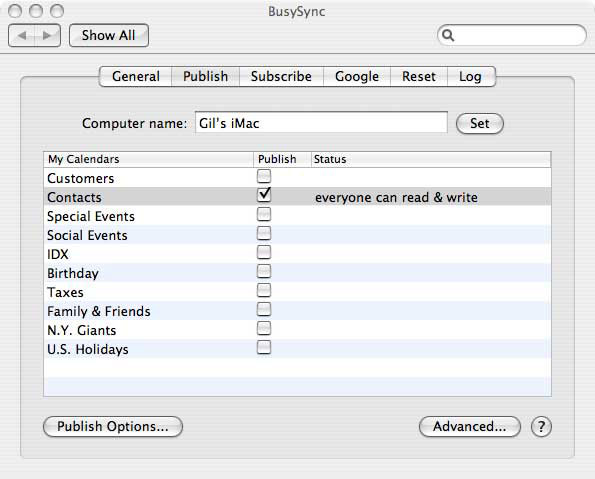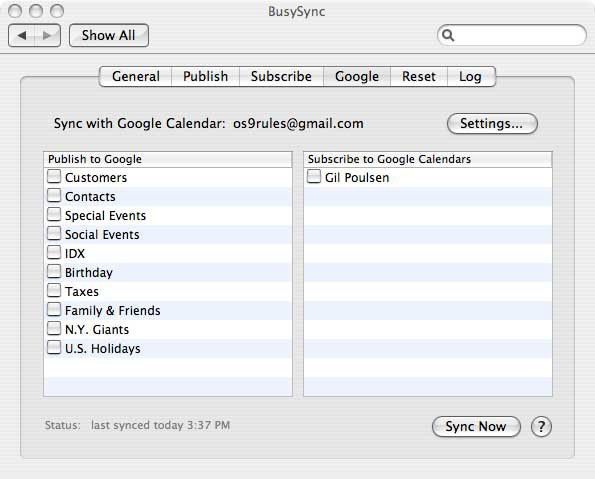![]()
BusySync 2.0
Company: BusyMac
Price: $24.95 ($19.95 through end of April), discounts for multiple licenses applied at checkout
http://www.busymac.com/
As useful as Apple’s .Mac sync services can be for families and small workgroups, there are a number of issues with its iCal synchronization that have kept me on the lookout for viable alternatives. My specific concerns with .Mac revolve around the following:
• Users on the same .Mac account cannot share some calendars while keeping others private; with .Mac it’s all or nothing
• The .Mac service is prone to service outages that, depending on your perspective, range from the occasional to the all-too-frequent
• For many OS X 10.5 (Leopard) users, particularly those in a mixed environment of OS X 10.4 (Tiger) and Leopard machines, the problems with .Mac calendar synchronization are legion (see info and possible solutions here)
Having unsuccessfully applied various fixes to address the latter issue for a number of my clients, I was eager to provide an alternative that would be easy to configure, inexpensive, and at least as reliable as .Mac. That ruled out the new group calendaring options in Leopard Server (too expensive at $999), as well as setting up a Mac-based WebDAV server using the example info at Greg Westin’s site (configuration and troubleshooting far beyond the abilities of a “normal†user).
As if on cue, enter BusySync. This program easily fulfilled the above requirements, and after spending a few days trying it out, my clients have been able to disable their .Mac calendar synchronization without missing a beat. For one design group, we have it working over the Internet as well as locally, after doing some simple port mapping at their router (more on that later).
BusySync installs as a preference pane and is dead simple to configure. In the “Publish†tab, all your iCal calendars are displayed in the precise order each calendar appears in iCal (a nice touch if you’ve got a lot of calendars and you’re a neat-freak like me). To share any or all calendars, you simply check the box in the “Publish†column, whereby you are prompted to enter passwords to allow read-only or read-write access for each. If you don’t enter any passwords, those who subscribe to your calendar(s) can view and edit them without restriction. This ability to keep some calendars private, while allowing others to be viewed or edited—with or without password protection—represents a quantum leap beyond .Mac’s bare-bones calendar sharing.

In BusySync’s “Publish†tab, all your iCal calendars appear, in the precise order in which you’ve arranged them in the iCal program. Just click the Publish button, set passwords for read only or read/write access, and your calendar is instantly available to anyone else on your local network.
Thanks to Apple’s Bonjour networking technology, any calendars you’ve chosen to publish appear automatically for all other users on your local network. To subscribe to other users’ calendars, click the “Subscribe†tab and place a check in the box next to each calendar you wish to access. If said calendar is password-protected you’ll be prompted to enter the password at this point. The calendar(s) to which you’ve subscribed will then appear in your iCal application and, like your own calendars, can be assigned a unique color if you desire via the Info tab. In this way, multiple users can edit multiple calendars, with all changes synchronized immediately over the network.
That’s really all there is to it in terms of calendar sharing and syncing over a local network. The programmers were thoughtful enough to include not only a “Reset Busy Sync†option, which turns off all your published calendars while removing all calendars to which you’ve subscribed, but also a “Restore iCal from Backup†option (via any one of the ten daily backups BusySync creates of your entire iCal database). So even if a wonky iPhone or Treo—or fumble-fingered family member—fouls up your calendar data after a sync, the BusySync folks have your back. There’s also a handy “Reset Sync History†button that saves you a trip to the iSync preferences should you find you need a complete reset of your sync history, something that seems to be required all-too-often when multiple users try to keep calendar and contact data synced reliably via .Mac.
Ah, but how does BusySync stack up against .Mac when it comes to sharing calendars across the Internet? Quite well, as it turns out. If you’re the patient sort, who doesn’t demand instantaneous updates to shared calendars, you can still view and edit both your published and subscribed calendars to your heart’s content when offsite. Any changes you make to your own published calendars—as well as those to which you’ve subscribed—will be synchronized with all other users when you reconnect to your local network.
On the other hand, perhaps you require constantly-updated calendar info, regardless of your location. Never fear, BusySync has this scenario covered as well. By setting your calendars to publish using a static port number (BusyMac suggests 4990 but you can use any port you wish) and mapping this port in your router to the your machine’s IP address, you and other users can view and edit your calendars from across the vast reaches of the Internet using BusySync’s “Add Remote Server†option. If this sounds intimidating to configure, rest assured that the BusySync online user’s guide covers this setup in great detail.
As if that weren’t enough, the technophobes among you will be encouraged to know that once port mapping has been configured at your router and your calendars have been subscribed to locally, BusySync is smart enough to determine whether you’re sitting on your local network or sitting at your local Starbucks, and present all subscribed calendars to you accordingly. Note that updates to calendars when accessed over the Internet may take a few moments to register, but that seems a small price to pay for all this functionality and convenience.

BusySync allows you to use your Google calendar account as a “conduit†through which you can synchronize your iCal calendars. Clicking the “Publish to Google†box by any of your calendars not only makes them available to you from your Google account, but allows other BusySync-equipped Macs on remote networks to subscribe and synchronize.
Plus, thanks to the Google Calendar syncing options in version 2.0, you can employ a Google calendar as a “conduit†to enable you to sync multiple iCal calendars without needing to bother with the port mapping/Remote Server setup described above. Once you’ve configured BusySync with your Google account login, simply publish the calendar to Google from one computer via BusySync, then subscribe to it on another computer from the list of published Google calendars that appear in BusySync’s Google tab. If you have alarms set up for various iCal events, rest assured that they’ll also be synced to the Google version of your calendars. When you’re viewing your calendar on Google, you can choose to have those alarms appear as pop-ups, text messages or email alerts.
All in all, I find myself hard-pressed to conjure up any negatives about this product. The price is extremely reasonable at $24.95 ($19.95 through the end of April), and BusyMac offers 10% discounts on five copies or more, 20% when ten or more are purchased and a whopping 30% off for orders of 25+. It’s one of those apps that “just works,†and I now have two clients in the field using it without incident, both of whom are quite pleased to be freed from the vagaries and idiosyncrasies of iCal syncing via .Mac. It’s probably unfair to point out that BusySync can’t sync contact info as .Mac can, but it doesn’t claim to be a complete .Mac replacement, only a simple, reliable way to publish and subscribe to iCal calendars.
In the course of a phone conversation a few months back, one of the BusyMac principals indicated to me that they were exploring the development of a contact-syncing application that would allow Address Book to publish and subscribe, in much the same way BusySync manages this for iCal. Given that the founders of BusyMac, Dave Riggle and Tom Chaffee, brought us the venerable Now Up-To-Date, they certainly seem up to the task.
Here’s hoping it’s already on their calendar.

Leave a Reply
You must be logged in to post a comment.